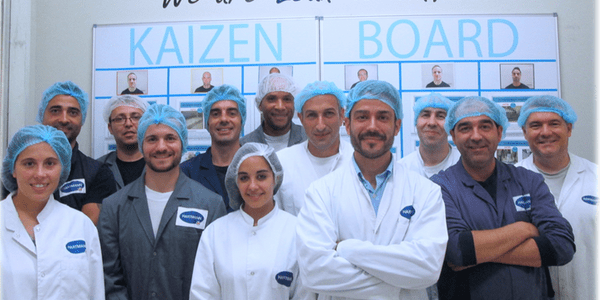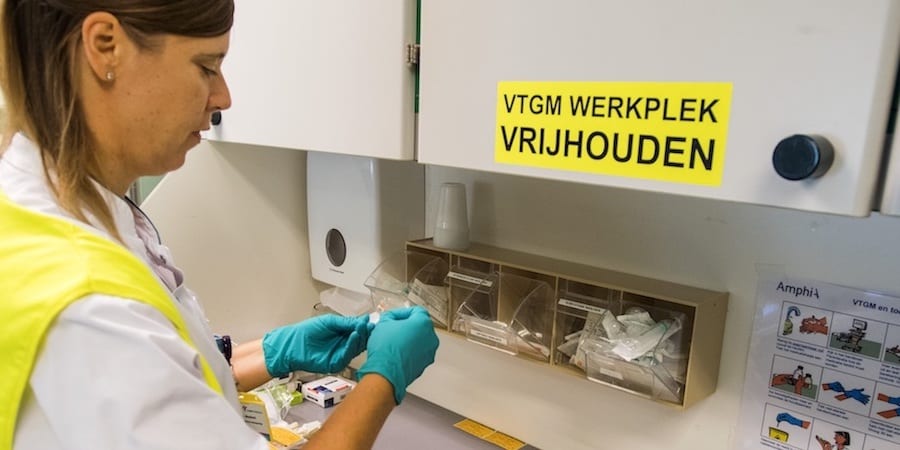
Employees: the most important part of a lean transformation
CASE STUDY - Through the involvement of front line staff, Hartmann’s production plant near Barcelona is paving the way for an expansion into different markets and inspiring the adoption of lean across the multinational.
Words: Jonathan Escobar, Global Head of Lean Management - Paul Hartmann Group
A lot is changing here at Hartmann. As we aim to become a world-class company by delivering the highest value to our customers, we need to develop our organizational capabilities to unlock our huge human potential. We realized that we needed to become a lean enterprise.
The Hartmann Group is an international manufacturer of medical and healthcare products. Here in Mataró, Catalonia, the company has one of its 25 production sites.

Our plant is a Global Competence Center within the group: it is the only manufacturing site dedicated to the R&D required to produce the adhesive technology used to coat Hartmann products. It exports nearly 90% of its production.
The site doesn’t only excel in R&D and exports, however. There is something else in which it is leading the way across the Hartmann Group: the level of maturity in the adoption of lean thinking.

The transformation in our plant is distinctive for the way front-line staff and the teams themselves have grown and the way the whole organization is changing with the goal of enabling front-line teams to perform value-added work and carry out continuous improvement activities.
The driving elements of this engagement (which we see every day in our people’s work) are a compelling value-driven purpose, lean-based guiding principles, management systems and leadership behaviors, and the kaizen mindset (in process improvement and capability development).
What made possible to lay down the building blocks of this transformation, which is inspired by LGN’s Lean Transformation Model, was the work we have been doing at the gemba.
WHAT IS OUR TRUE NORTH?
To engage the entire organization we used a powerful visual approach, ensuring everybody could see our purpose the way we see it. It’s the Big Picture, our true north. Transparency was a necessary step in building a common framework for being able, later, to work on the hoshin catchball that connects front-line individual goals with customer satisfaction and business needs.

The power of this visual approach comes from the widely promoted idea that we are all responsible for the construction of this building, engaging front-line teams in this process, and helping the rest of the organization to understand their role in it and supporting the value-added work of the front line.
Engagingeverybody in the change process has become the vehicle for healthy conversations, to understand doubts and build consensus on how the lean transformation can help us to achieve our purpose.
WHAT BASIC THINKING UNDERLIES OUR TRANSFORMATION?
The basic mindset defining our approach to our lean transformation is expressed in the L.A.C.E (Leadership-Accountability-Commitment-Execution) framework, whose principles have guided us, putting the “customer is boss”, “respect for people” and “improve or nothing” core beliefs at the centre of our every decision.

These principles were previously just a vision, but are now a written expression of how people think, work and behave in our plant. They continuously pop up in the conversations we have at the gemba.
HOW DO WE IMPROVE THE ACTUAL WORK?
We haven’t implemented tools and kaizen as isolated projects, programs or events; instead, we have integrated them into seven Daily Management Systems (DMS), which are owned by front-line teams.
These systems have become the supporting structure of our Daily Direction Settings (DDS), the framework that allows for daily accountability and ownership through Hoshin PDCA-SDCA at the process level.
DDS provide all team members with the time, resources and support they need to execute kaizen, innovate, learn by doing, and carry out effective problem solving. The goal is to learn from mistake and defects and being able to develop systematic countermeasures (focused in capability development) to ensure that deviation doesn’t occur again.
“Many good American companies have respect for individuals, and practice kaizen and other TPS tools. But what is important is having all the elements together as a system. It must be practiced every day in a very consistent manner—not in spurts—in a concrete way on the shop floor.”
Fujio Cho, President, Toyota Motor Corporation

The DDS image above represents the heart of the learning and capability development culture developed through daily work improvements at Hartmann.
To this end, the DDS is also a process of continuous improvement with key “moments of truth” occurring in every shift:
- The “zero” moment of truth happens when improvements and/or deviations are found. Therefore, people’s ability to grasp the situation and define the problem at the gemba is key;
- The first moment of truth happens when teamwork is developed in the morning and shift overlap meetings around the obeya board for the hoshin DDS at process level. At this point the team’s capabilities to work the double PDCA-SDCA loop for problem solving and kaizen start to make a difference;
- The second moment of truth happens in planned stops, when the countermeasures or kaizens are implemented and the consequent check and hansei follow. Here is when all of the developed capabilities show the performance results they have brought: teamwork to build an effective and well-coordinated plan; autonomy to execute the required tasks just-in-time without any external support; and initiative to stop, reflect and act in case non-planned issues come up or things don’t work as expected.
In the end, beginning with the moment in which each kaizen or deviation comes up, an A3 cycle is started where the leader becomes mentor and the operator becomes “owner” of the process of eliminating the root cause of deviation or implementing kaizen.
For this purpose, the DDS provides the framework and the DMS the specific vehicles to develop our people through shiftly kaizen, striking a delicate balance between just-in-time (executed through Master Production Scheduling Daily Management System) and jidoka (executed through other key Daily Management Systems).
Our system for process improvement is at the same time our people development system.

HOW DO WE DEVELOP PEOPLE?
In Mataró we have based our development program on building ownership of front-line teams, turning operators who were just expected to “push a button” into business owners who improve the process on every shift while working to meet the just-in-time principle through the Daily Direction Settings.
The DDS enables continuous on-the-job training to solve customer problems, innovation in product/process technology and improvement of the work that adds value to our products: that’s the foundation of our capability development program.
I must say I don’t like class-based workshops much. The longest we have organized here in Mataró was a one-day workshop (on lean culture). All the training here at Hartmann happens at the gemba with the Instituto Lean Management as our partner. It’s all on-the-job, with only one or two hours spent in the classroom to grasp the theory.

Technical leader (blue) working with front-line owner (white) to improve a process[/caption]The ownership we have been able to instil in our people’s minds has been the key to unlocking their potential. Being an “owner” means being responsible and accountable for developing your capabilities in order to continuously improve the area of the value stream you are working in.
Front line owners don’t just focus their improvements on the processes but also on the daily management systems, the standard work and even the operating capabilities of other team members within their area. Today, the shift work of each owner is basically driven by these two key concepts:
- I pursue the “reds” to eliminate whatever the customer doesn’t perceive as value and therefore doesn’t want to pay for and to improve whatever the customer does value.
- What can I do against root cause/s so that this problem (that produces costs that the customer is not willing to pay for) doesn’t’ occur again?
With this mindset, each owner addresses things that do not go as they are supposed to, taking responsibility for proposing and implementing countermeasures, and contributing to developing other team members.
What enables the execution of the key DMS is our “swimming pool” boards, which are placed directly in front of the machines and help us to run the development of individuals and teams in a transparent way through the kaizen process.

The swimming pool works as an oobeya board for the kaizens performed by each team member and by the whole team. Each owner uses this space to:
- Track the completion of the activities in each phase and call for action to effectively prioritize or speed up in the event of deviation;
- Trigger leadership support, when a major investment or discussion is required;
- Trigger nemawashi, when team consensus or activity is needed to work around the root causes of a problem or a kaizen and to make team decisions geared towards the required changes;
- Trigger the immediate implementation of a solution as soon as it is available.
With this board, the kaizen and skill development activities are linked visually. Working with owners there you can see how their autonomy and ability to innovate, as well as the team’s self-sufficiency and mutual trust, grow every day, on every shift.
It’s great to see how the guys are working today: they are strengthening their skills and challenging their thought process to improve themselves, so that they can then improve the business.
At the same time they are encouraging the organization to remove the barriers preventing them from improving things. They are setting the example and thus helping to transform the mindset and the work dynamics of a big part of the business.
WHAT ABOUT LEADERSHIP?
In the first stages of the transformation, with its purpose clear, Hartmann started to develop its hoshin for the next few years. A necessary step in that direction was the preparation of a strategic A3 to come up with a new organizational design to divide staff into value stream teams.
The A3 resulted in an action plan to develop a holistic organization where people, processes, communication systems, decision-making, and recognition systems are connected in value streams to allow for the creation of self-sufficient teams.
At the same time, other strategic A3s were prepared with the value stream teams to break down SQMDC goals into in-process and capability development objectives.
And this is how catchball started to happen to build our hoshin framework.

To me, hoshin is pure magic. By continuously working with the teams, the correlation between long-term goals and individual accountability on every shift proved extremely powerful. You are essentially building a direct link between the company’s purpose and every individual’s work. The workplace becomes a place where people matter, where their efforts and initiative matter, and where owners can see how their work on problem solving and kaizen impacts on the company’s purpose.
With this in mind, each team started to build its own oobeya board as Hoshin Check&Hansei Points in front of each machine.
We use two levels of Hoshin Check & Hansei points: the Value Stream PDCA and the DDS following the PDCA-SDCA cycle at process level.
With the Hoshin Value Stream PDCA, teams define concrete annual objectives linked to the larger goals and then translate these concrete objectives into meaningful quarterly action plans with monthly targets for visual check. DMS and SWP become the core of the hoshin PDCA at value stream level and the link with hoshin at process level. All actions and targets are expressed in terms of shiftly DMS and SWP activities and behaviors.

Therefore, front-line development to achieve excellence in DMS performance becomes the common focus for the entire team, and the key to meet larger goals and objectives.
At process level, each team member is accountable for the performance of the DMS in their area of responsibility, in each machine, on every shift.
A3 thinking is used to understand the gaps in the development of skills and the execution of systems before they prevent us from achieving larger goals. We go through our DMS targets on every shift, striving to prevent reds from appearing. If they do appear, we define and implement the countermeasures.
At all levels, but especially at value stream and process levels, the oobeya boards have become spaces where team members, team leaders and plant leaders observe the reality around them. They have become the common element of the machines at the gemba, and the space for nemawashi where we try to grasp the situation and share our understanding. This is the basis to agree on actions necessary to eliminate the root cause of deviation or properly complete the agreed kaizen.
Teams work all the time on improving visual management so that the boards don’t just represent “status displays” but rather a trigger for root-cause analysis and action-taking whenever a red appears. They are also the place where the coaching takes place and the work is observed.

Of course, leadership behaviors and responsibility are critical elements to all of this. This is why we are growing leaders from within: six have so far been challenged to move from their previous departmental roles within Hartmann to become facilitators of the lean transformation.
Leadership attitude and commitment are not negotiable. Leaders must build a deep understanding of the work at the gemba, and never stop learning so they can keep coaching and teaching. They must challenge organizational assumptions and bring problems to the surface, connecting the work at the gemba with our value-driven purpose.
People don’t work for us, we should never forget. We work for our people, developing their skills to improve the work that our customers value. This belief is at the heart of everything we do.
HOW THE IMPLEMENTATION IS UNFOLDING
It is wonderful for me to work with such a high-performing team in Mataró, and I am very grateful for everybody’s contribution to our lean transformation.

It’s amazing to see how they work today and how their work has inspired an entire multinational with 25 manufacturing plants and 10,000 employees to go down the lean route.
Worldwide (throughout the group) lean has been around for over a decade, but the approach has been mainly tool-oriented. However, this means that the foundations are already in place and that, for instance, we already have a lean leader in each production site. We have now come to the conclusion that it is time to go the extra mile and achieve a cultural transformation across the company with a strong foundation on the operations network.
I am currently coaching the leadership team of a second factory within the group, which wants to go through its own lean transformation. Both factories will become the models for defining our holistic lean strategy.
Our “big picture” and L.A.C.E principles remain the drivers and main guide in the transformation process, but we now have to build the capabilities in top leadership to grasp the current state of purpose, process and people in each site. You can’t copy and paste transformations: it’s necessary to understand the principles of lean, grasp the situation of each business, and develop the different dimensions of the transformation model according to the actual situation.

That is the recipe to win and Mataró will be instrumental in helping the rest of the Hartmann Group to accomplish a long-lasting transformation.
Pictures copyright: Jonathan Escobar - Paul Hartmann
THE AUTHOR

Read more


OPINION – It might seem like a subtlety, but the distinction between discussion and dialogue is actually fundamental as we try to find new ways to unleash organizational creativity.


FEATURE – How does the improvement department of a company become a hindrance to the transformation? The author answers this question and discusses how this can be avoided.


FEATURE – If we see lean thinking as a paradigm, which we do, then we should be able to define a set of values this paradigm is built on. So, are there lean ethics? Michael Ballé identifies 10 undisputed lean values, plus one.


INTERVIEW – Bringing nurses together and giving them a space to discuss problems on a regular basis has allowed this hospital in Holland to successfully embrace lean thinking and reap its benefits.

